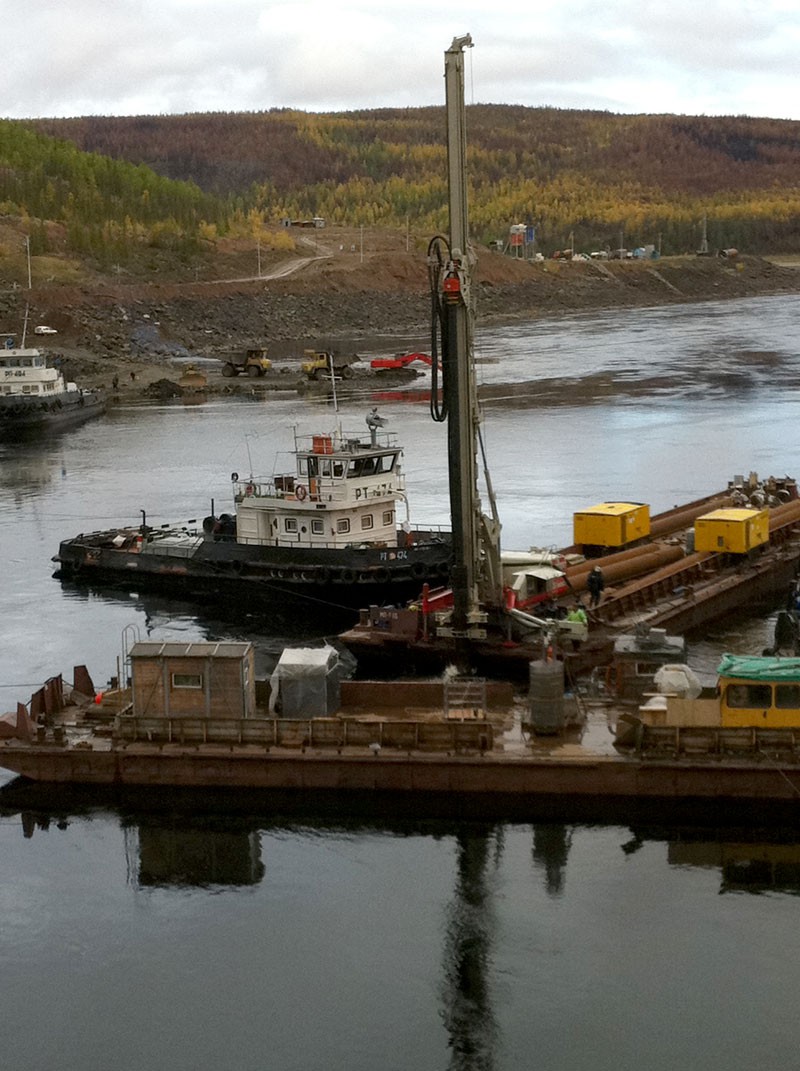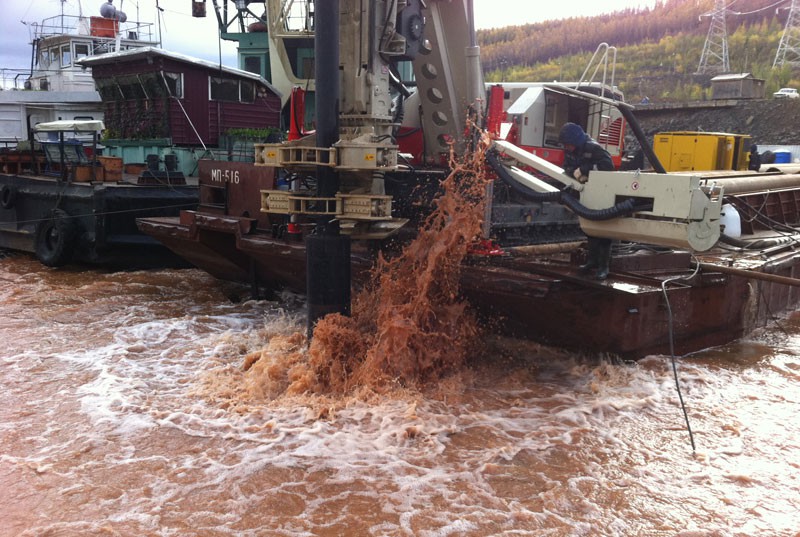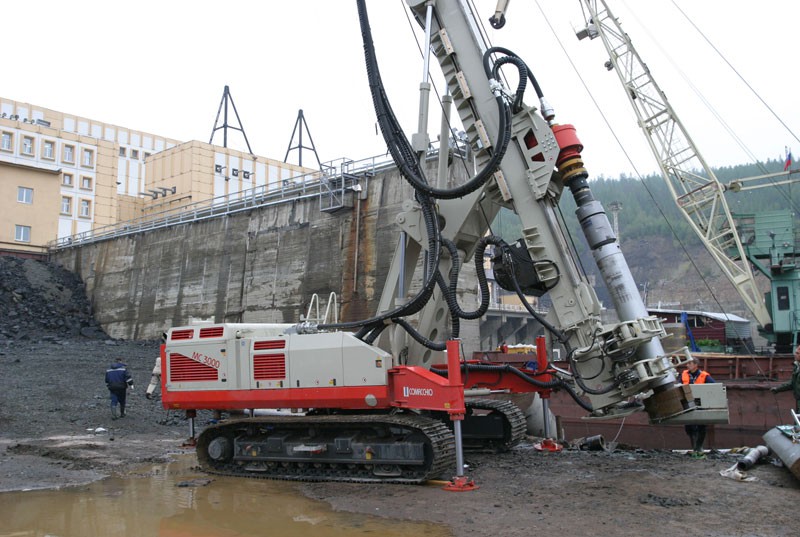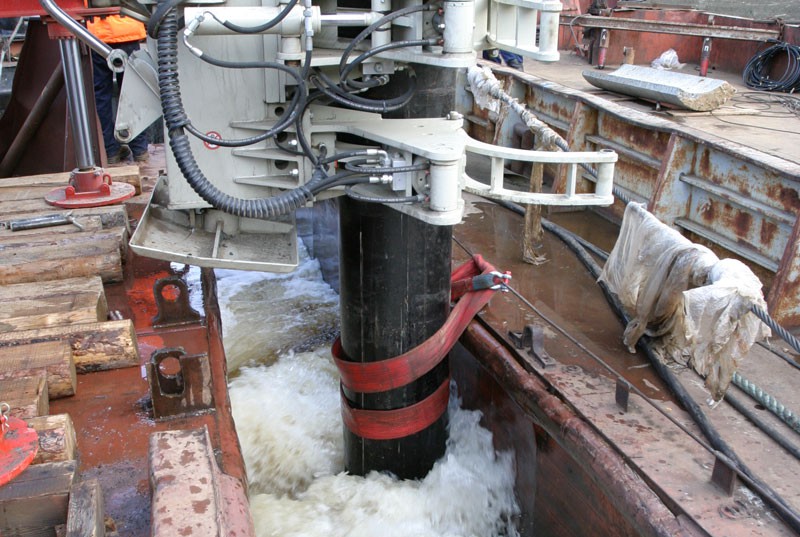DATE: 2013 - 2014
MODEL: MC 40 (MC 3000)
Comacchio drilling rig MC 3000 performs installation of sheet pile retaining wall on the Svtelinskaya hydropower plant on the Vilyuy river.
The Svetlinskaya HPP is the first and only hydroelectric plant in the world built on permafrost instead of rocky ground, on the banks of the Vilyuy River, in the Sakha Republic in the far east of Russia. This subarctic area is characterized by extremely cold winters with average temperatures from −39 °C to −32 °C in January.
The design of the plant, which started in the late 70s, required a series of innovative technological solutions and was carried out by the Lenhydroproeject research institute (part of Rushydro). In 2008 the station was officially commissioned with three (out of the four) generators. The planned output of the plant is 360MW with an average annual production of 1.2 billion kWh. Since the launch of the 3 of the 4 generators in 2008 the capacity of the plant is currently estimated at 270 MW.

The composition of the hydro-power plant includes a left-bank rockfill dam (112 m long with a maximum height of 50 m), a right-bank rockfill dam (273 m long and with a maximum height of 50 m), inlet and outlet channels and the combined run-of-river powerhouse.
A design feature of the bottom of the outlet waterway of the plant is the covering of the channel soils with reinforced concrete plates across the entire width of the channel (about 135 m), with a special elevated part ("apron") at a distance of 53 - 100m from the edge of the hydroelectric dam. During the operation of the hydroelectric power station, due to the strong turbulent flow of the water, the apron slabs situated farthest from the wall of the dam collapsed. The remainder of the apron was under threat of under-washing and destruction.
To prevent further destruction of the reinforced concrete plates composing the apron, at the level of the 5th row, at a distance of 74 m from the edge of hydroelectric dam, St Petersburg-based company LLC Stroitelnoe Upravlenie (Construction Department) N. 299 was commissioned to construct a sheet-pile wall over the entire section of the outlet waterway. The design was developed by the Hydroproject design institute, with participation from the contracting organization, and includes the installation of 155 pipes with 720 mm diameter into the soil beneath the concrete plates of the apron to a depth of 11.5 m.
“Carrying out of the work is planned for two summer/autumn seasons (2013 – 2014), when the load on the power units of the plant is reduced to 40 - 50 MW, the tail race water level drops to 8 - 8.5 m, and the flow velocity of water in the outlet waterway is 0.5 - 1.0 m/s, thus allowing us to perform diving operations,” explains V. Klimov, academic consultant and development director at Stroitelnoe Upravlenie N. 299, one of leaders of the project, which is managed by project director V. Korshunov. “The ground below the concrete slab is made by thawed alluvial channel deposits: boulders (20-30%), pebbles, gravel with sandy-loamy filler (20%) (detritus of chert and dolerite), red-brown loam featuring layers of very weak siltstone, incorporating pebbles, gravel, chert up to 5%. At the bottom of the cut - uneven interbedded siltstones, marls, sandstones and mudstones of medium hardness, gravel, scree with reddish-brown loam (10-15%)”.
Part of the project was completed in the summer and autumn of 2013.
The work process was organized in four stages:

The diamond drilling involved in the first stage was performed using two concrete-drilling machines mounted on a concrete base and equipped underwater lighting and video surveillance systems. Drilling was performed with underwater positioning of the machine by a diver using a floating crane. The hydraulic power pack on a barge was connected with the rig through high-pressure hoses. The machine was controlled by an operator on the barge with help from the images transmitted by the cameras. “Removing the concrete core of the plates was not easy,” explains Klimov “Also, drilling of the fractured areas of the concrete plates was particularly complicated: loose fragments of the core and unfixed pieces of rebar led to seizure of the drilling tool in the borehole and drilling machine breakdowns,” Klimov sais “but we are proud to report that such underwater diamond drilling with a diameter of 1000 mm was performed for the first time in the world”.
The next stage involved the installation of sheet piles by means of rotary-percussive drilling through the grooves created.


The installation of the sheet-piling pipes with 720 mm outer diameter and 10 mm wall thickness was performed by means of an 18” (45.7 cm) down-the-hole (DTH) hammer using overburden drilling system. Three-meter-long m long canned rods of 273/530 mm diameter, weighing 1052 kg each, have been specifically designed and manufactured for this project in the Czech Republic.
A drilling rig to carry out this project had to fulfill specific requirements, including: